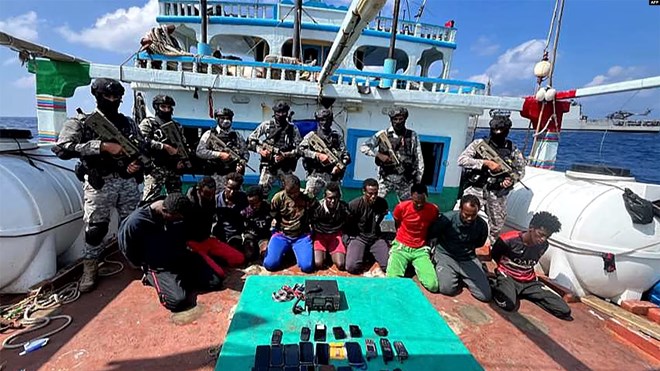[ad_1]

Thursday February 8, 2024

Indian commandos stand guard with a group of detained pirates after the Indian navy freed an Iranian fishing vessel hijacked by Somali pirates, off the Somali coast, west of Kochi, India, Jan. 30, 2024. (Indian navy photo)
NEW DELHI — From helping douse a fire on a Marshall Islands-flagged tanker hit by a Houthi missile on January 26 to rescuing vessels hijacked by pirates, Indian navy warships have been providing security to merchant ships in the Arabian Sea.
India has not joined the U.S.-led task force for the Red Sea that is launching strikes against Yemen-based Houthi rebels, who have mounted missile and drone attacks on commercial ships in response to Israel’s war against the militant group Hamas, disrupting global trade.
But India has deployed at least 10 warships that include guided missile destroyers and surveillance aircraft to police waters east of the Red Sea as it seeks to project power in the Indian Ocean in the face of the threat from Houthis and a resurgence in piracy.
The naval deployment signals India’s aspirations to be counted as a responsible power, say analysts.
“I think the scale of India’s naval deployment is quite unprecedented, and in some ways this represents the confidence the Indian navy has in its own abilities and the requirement to be seen as a benevolent regional player that is not simply looking after its own interests but also the interests of the global common,” Harsh Pant, vice president of studies and foreign policy at the Observer Research Foundation in New Delhi, told VOA.
The Indian navy has helped at least two ships that were struck by drones and missiles since December, according to officials. But its main focus has been on conducting anti-piracy patrols. The navy said that last week it rescued two Iranian-flagged fishing vessels that had been boarded by pirates and safely released the crew members who had been taken as hostages.
“It was a little worrying for India that the pirates were striking almost in the middle of the Arabian Sea, which is far from Somalia where pirates used to strike earlier,” Captain D.K. Sharma, former navy spokesman, told VOA. “That is why this deployment has happened – to scan the area, sanitize the area.”
New Delhi hopes its navy’s presence will be a deterrent, preventing the threat to merchant vessels from spilling beyond the Red Sea. India’s trade, much of which passes through these waters, has also been impacted.
“We are one of the biggest naval forces here, and we know the world’s trade is moving through these routes and we support freedom of seas, freedom of navigation,” Sharma said.
India’s focus has long been on the army because of the country’s decades-long border disputes and hostilities with China and Pakistan in the Himalayas. However, in recent decades, India has also been acquiring more advanced ships, submarines and reconnaissance aircraft to build its naval prowess and make the country a more potent maritime force.
Commissioning a hydrographic survey ship Sunday in the southern Indian city of Visakhapatnam, Indian Defense Minister Rajnath Singh said the naval forces aim to protect both trade and regional security.
“The Indian navy has become so strong that we have become the first responder in terms of security in the Indian Ocean and Indian Pacific region,” Singh said.
Boosting its naval heft in the Indian Ocean, which India calls its backyard, has become a priority for New Delhi, as it seeks both to protect the sea lanes through which its trade passes and to counter China’s growing presence. Most countries in India’s neighborhood are part of China’s Belt and Road Initiative; for instance, Beijing has built ports in Sri Lanka and Pakistan. While China’s navy is far larger than India’s, New Delhi plans to add more than 65 new warships to its fleet.
Analysts say India has also taken a proactive role in helping counter the threat facing global trade to signal that it is an emerging power. Since taking office in 2014, Prime Minister Narendra Modi has been trying to boost India’s global image.
“I feel today that India’s greater capability and our own interest and our own reputation warrant that we help out in a difficult situation,” Foreign Minister Subrahmanyam Jaishankar said last week at a public event, referring to India’s deployment.
Traditionally, New Delhi joins only those military coalitions that the United Nations approves, but Pant said it shares the same aim as the U.S.-U.K. coalition working in the Red Sea: protecting global trade.
“Increasingly India is saying that we are willing to work with the world towards collective ends; we are not a disrupter to the global order, regional order; we want to be a responsible stakeholder,” Pant said. “So naturally if there is a crisis happening around your periphery, India has to step up to the plate and make its own contribution, whether it is small or large.”
[ad_2]
